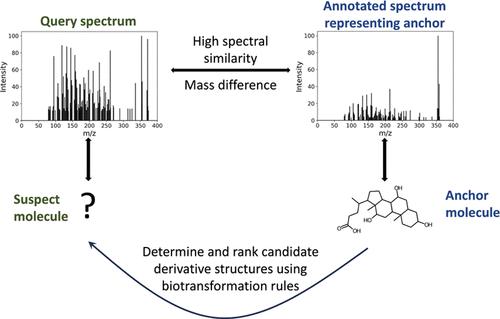利用生物转化规则和全球分子网络发现非靶向代谢组学的分子结构
IF 6.7
1区 化学
Q1 CHEMISTRY, ANALYTICAL
引用次数: 0
摘要
尽管基于非靶向质谱的代谢组学对于理解生命的分子基础至关重要,但其有效性受到产生的串联质谱的低注释率的限制。为了解决这个问题,我们引入了一种新的数据驱动方法,基于生物转化的注释方法(BAM),它利用了生化反应中固有的分子结构相似性。BAM的工作原理是将生物转化规则应用于已知的“锚定”分子,这些分子与未知的光谱具有很高的光谱相似性,从而假设并排列相应的“可疑”分子的潜在结构。BAM的有效性通过其在包含数亿个光谱的全球分子网络中成功注释查询光谱证明了它的有效性。BAM能够为24.2%的锚定可疑病例分配正确的分子结构,从而在代谢物注释方面显示出显着的进步。本文章由计算机程序翻译,如有差异,请以英文原文为准。

Molecular Structure Discovery for Untargeted Metabolomics Using Biotransformation Rules and Global Molecular Networking
Although untargeted mass spectrometry-based metabolomics is crucial for understanding life’s molecular underpinnings, its effectiveness is hampered by low annotation rates of the generated tandem mass spectra. To address this issue, we introduce a novel data-driven approach, Biotransformation-based Annotation Method (BAM), that leverages molecular structural similarities inherent in biochemical reactions. BAM operates by applying biotransformation rules to known “anchor” molecules, which exhibit high spectral similarity to unknown spectra, thereby hypothesizing and ranking potential structures for the corresponding “suspect” molecule. BAM’s effectiveness is demonstrated by its success in annotating query spectra in a global molecular network comprising hundreds of millions of spectra. BAM was able to assign correct molecular structures to 24.2% of examined anchor-suspect cases, thereby demonstrating remarkable advancement in metabolite annotation.
求助全文
通过发布文献求助,成功后即可免费获取论文全文。
去求助
来源期刊

Analytical Chemistry
化学-分析化学
CiteScore
12.10
自引率
12.20%
发文量
1949
审稿时长
1.4 months
期刊介绍:
Analytical Chemistry, a peer-reviewed research journal, focuses on disseminating new and original knowledge across all branches of analytical chemistry. Fundamental articles may explore general principles of chemical measurement science and need not directly address existing or potential analytical methodology. They can be entirely theoretical or report experimental results. Contributions may cover various phases of analytical operations, including sampling, bioanalysis, electrochemistry, mass spectrometry, microscale and nanoscale systems, environmental analysis, separations, spectroscopy, chemical reactions and selectivity, instrumentation, imaging, surface analysis, and data processing. Papers discussing known analytical methods should present a significant, original application of the method, a notable improvement, or results on an important analyte.
 求助内容:
求助内容: 应助结果提醒方式:
应助结果提醒方式:


